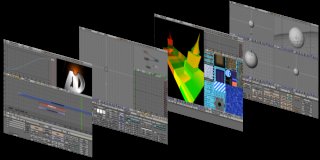| 02.2 Screens & Windows
Each blender file can have an unlimited number of screens.
A screen can be subdivided in windows (like HTML frames) and be given a
certain function.
Each window has a header, at choice at top or bottom.
The leftmost button displays, as an icon, the window type.
To resize a window simply move the mouse cursor to the
window edge. The cursor changes shape. Press and hold LeftMouse to move
the edge.
Press MiddleMouse to Split the window.
Press RightMouse to join two adjacent windows.
As usual for a window system, only 1 window is active
at a time, and only this window receives the user input. Every window type
can have a different mouse and keyboard handling.
A screen - and all its windows- always shows 1 Scene.
Other screens can show different Scenes. This is sometimes confusing, so
it's an user option.

At the top of a screen usually the Info window is located.
It shows the Scene and screen name and - as text - a
lot of statistics. If you pull down the window edge, you find the user
options. These will be discussed later.
These are the other window types:
- 3D window: display wireframe/solid/GL-lighted/rendered
- Buttons window. Scalable!
- Curve window. For animation curves and keys.
- Schematic diagram window.
- Sequence editing window. For video editing and post
production.
- File selecting and file management windows.
- Image window.
< site under construction !!!>
|
 introduction
introduction